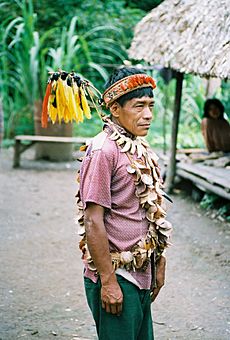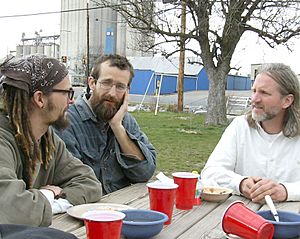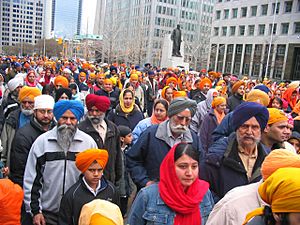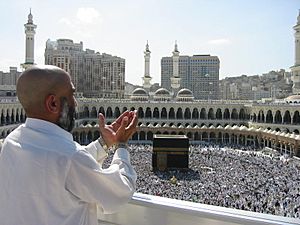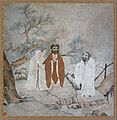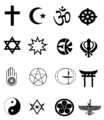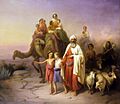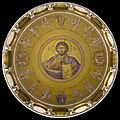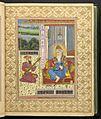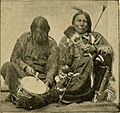Religion facts for kids
A religion is a set of beliefs and practices shared by a group of people. It helps them understand the world and their place in it. These beliefs often guide how people act and what they do. Many religions include special actions called rituals.
There are many different religions, each with its own ideas. These ideas are about how the world and people came to be, and what their purpose is. Some religions believe in supernatural beings like God, many gods, or spirits. Others focus on a path for each person's spirit towards goodness, truth, and duty. This is often called spirituality.
Every religion has its own "moral code." This is a set of rules about how people should treat each other. Religions also have ways for people to show their devotion, like worship or prayer. They often have special rituals for certain times of the year or important life events. Other words for religion include "faith" or "belief system." People who follow a religion are called 'believers' or 'the faithful'. Most people follow only one religion.
The largest religions include Christianity, Islam, Hinduism, Buddhism, Taoism, Sikhism, Judaism, and Jainism. There are many other religions too. People who do not believe in any gods are called atheists. Those who say there is no proof for gods are called agnostics.
Contents
Religious beliefs
God and spirits
In many religions, a main belief is that there is a "deity" or god. This god is often seen as a great creator spirit. Some religions believe in only one god. Others believe in many gods, each with different roles in the universe. Many religions also believe in other types of spirits, like angels or devils, which can be good or bad.
Showing honor to God, gods, or spirits is a key part of most religions. This can be done privately, but it often involves groups of people and special rituals. These rituals are usually based on old traditions. They might have been done in the same way for hundreds or thousands of years.
Human spirit and afterlife
Another common belief is that humans have a "soul" or spirit. This spirit is thought to live on after the body dies. Many religions believe that what a person does in life affects what happens to their spirit in the afterlife.
Many religions teach that a good person's spirit can go to a special place of peace and happiness. Examples include Heaven or Nirvana. They also teach that a bad person's spirit might go to a place of pain, like Hell. Other religions believe in reincarnation. This means spirits return to Earth in a new body instead of going to Heaven or Hell.
Morality and how we act
"Morals" are the rules about how humans should behave towards each other. Most religions have rules about human morals. These rules can be different in various religions.
For some religions, following a "path" of goodness, truth, and duty is very important. This is called Tao in China. In Judaism, people were told to "love your neighbor as yourself." In the teachings of Jesus, people were told to treat everyone with love, seeing them all as their "neighbor."
Traditions
Teaching and stories
Religions are passed down through teachings and stories. These stories are sometimes called "myths." They might be written down, like the Bible. Or they might be told from memory, like the Dreamtime stories of Australian Aboriginal people.
Many religions have people who serve as "priests." They spend their lives teaching others about the religion. Some people are "pastors" who care for others. A person might be both. They are called different names in different religions.
Symbols
Symbols help people remember their religious beliefs. They are also used or worn to show others that a person belongs to a certain religion. A symbol could be a drawing, a piece of clothing or jewelry, a body sign, or a building or artwork.
Sharing beliefs and joining a religion
Many religions believe it's important to show others that you follow a particular religion. This might be done by wearing a symbol or special clothing. Many people also feel it's important to tell others about their religion. This is called "witnessing."
There are many ways to witness. A person might talk to friends or classmates about their beliefs. They might visit people's homes to share their faith. Or they might invite people to religious events, like church services or festivals. Some people give out books or leaflets. Others travel to different countries to teach, help with health services, or assist people in other ways. These people are called "missionaries."
When someone hears about a religion and decides to join it, this is called a "conversion." Usually, people choose to join a religion because they like what they've learned and believe it's true. They join because they want to. However, throughout history, some people have been forced to join religions through violence. This still happens in some places today.
In most countries, people are free to choose their religion. This is seen as a basic human right. But in some parts of the world, it is against the law to practice any religion except the one accepted by the government. People who belong to other religions might face threats, jail, or even death.
Rituals and celebrations
Rituals are a key part of many religious traditions. Many religions have a tradition of meeting for a celebration once a week. There are also major celebrations held at specific times of the year, like on the birthday of an important religious figure. Some religions have celebrations linked to the seasons or the position of the sun or moon.
Nearly every religion has special celebrations for important stages of a person's life. Birth, naming, coming of age, marriage, childbirth, sickness, and death are all celebrated by some religions. Having a celebration or special traditions when a person dies is very common.
The earliest evidence of religious beliefs comes from traditions about death. Scientists found that 120,000 years ago, Neanderthal people started burying their dead. Early Homo sapiens put tools and other items in graves, as if the dead could use them in the afterlife. From 40,000 years ago, many grave objects were small artworks. Scientists believe these were placed for religious reasons.
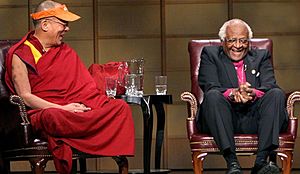
Groups and organizations
An institution is another word for an organization. Many religions have organizations that guide how followers should act. These organizations might employ religious leaders, educate people about the religion's ideas, manage money, own buildings, and make rules. Many religions also have smaller groups called denominations. For example, in Islam, there are groups like Ahmadiyya, Sunnism, Shi'ism, and Sufism.
Buildings
Most religions have special buildings where people meet. They are often called temples. In Judaism, they are called synagogues. In Christianity, they are called churches. In Islam, they are called mosques. In Buddhism, there are pagodas, temples, and monasteries. In Hinduism, they are called Mandirs. People often try to make their religious buildings as beautiful as possible. Some religious buildings are amazing works of architecture.
Art and music
People often create artworks about their religion. These artworks might be used in religious celebrations or placed in religious buildings. Religious art comes in all sizes, from tiny pieces of jewelry to huge statues and paintings. Artworks often give historians important clues about ancient religions that are not well understood today.
Music is often important in religious celebrations. Singing, chanting, and playing musical instruments are often part of regular religious gatherings. Special music is often used for special occasions. Many famous composers have written religious music. The words of some songs used daily in Christian churches and Jewish synagogues are 3,000 years old.
Related pages
Images for kids
-
The Buddha, Laozi, and Confucius in a Ming dynasty painting.
-
"Three laughs at Tiger Brook", a Song dynasty (12th century) painting portraying three men representing Confucianism, Taoism (Daoism), and Buddhism laughing together.
-
Religious symbols from left to right, top to bottom: Christianity, Islam, Hinduism, Buddhism, Judaism, the Baháʼí Faith, Eckankar, Sikhism, Jainism, Wicca, Unitarian Universalism, Shinto, Taoism, Thelema, Tenrikyo, and Zoroastrianism.
-
Budazhap Shiretorov (Будажап Цыреторов), the head shaman of the religious community Altan Serge (Алтан Сэргэ) in Buryatia.
-
The Yazılıkaya sanctuary in Turkey, with the twelve gods of the underworld.
-
The patriarch Abraham (by József Molnár).
-
The Torah is the primary sacred text of Judaism.
-
Muslims circumambulating the Kaaba, the most sacred site in Islam.
-
The Baháʼí Lotus Temple in Delhi.
-
The Temple of Heaven, a Taoist temple complex in Beijing.
-
Depiction of Lord Vishnu.
-
Wat Mixay Buddhist shrine in Vientiane, Laos.
-
An 1840 miniature of Guru Nanak.
-
Shango, the Orisha of fire, lightning, and thunder, in the Yoruba religion, depicted on horseback.
See also
 In Spanish: Religión para niños
In Spanish: Religión para niños



